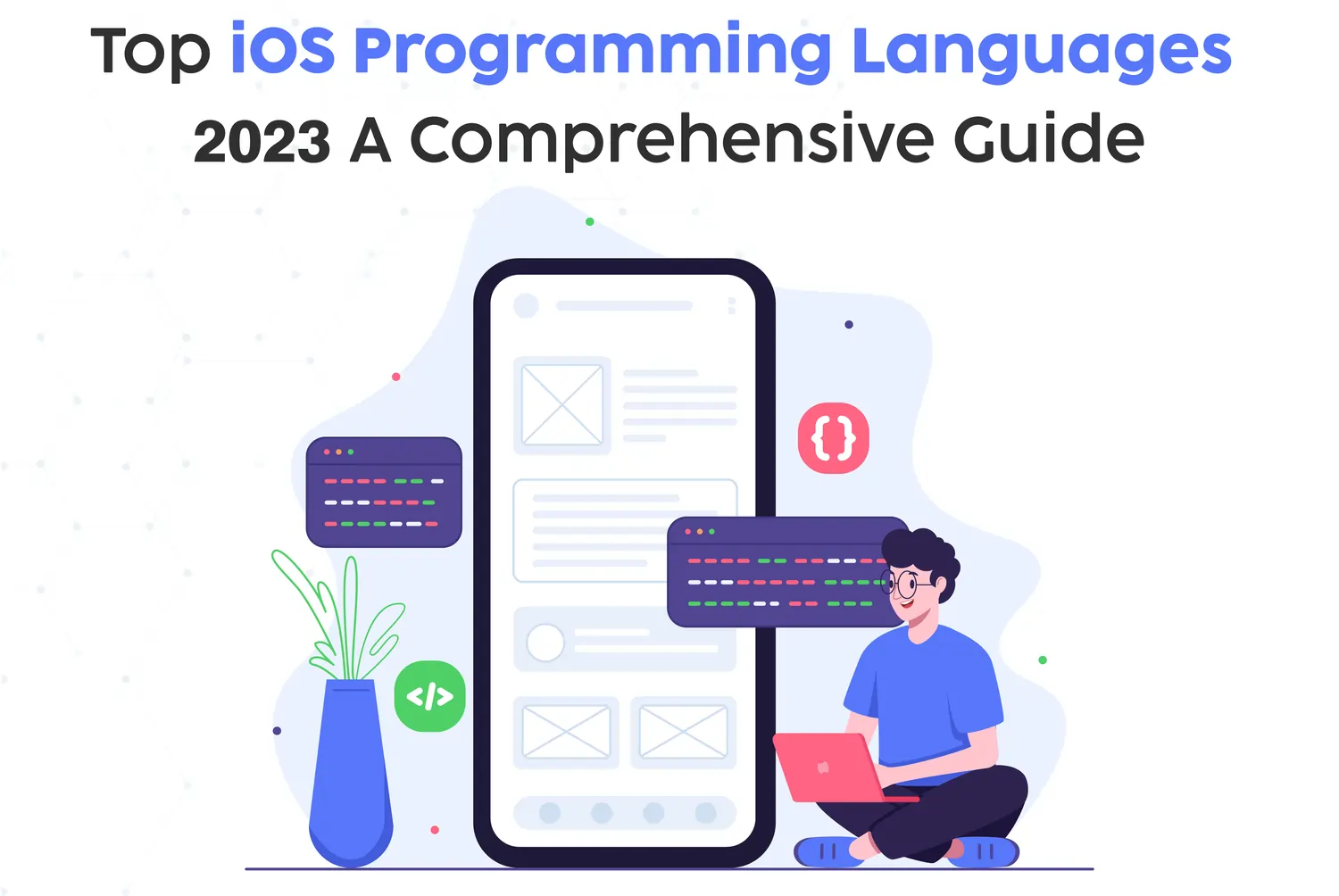
Know the best languages for iOS programming in 2023. Look at everything from Swift to Objective-C concerning what the developers go for, whether in speed, safety, or performance of the iOS application.
Highlights
An enthusiastic developer and skilled business management expert with over a decade of experience in the field

As we move deeper into the digital age, iOS programming languages continue to evolve and become increasingly important. With the rise of smartphones and mobile devices, more and more people are relying on iOS applications to accomplish their daily tasks. As a result, developers must keep up with the latest trends and technologies to create high-quality apps that meet the needs of their users.
Want to design a winning app? Check Digittrix's 7 easy design rules to build a user-friendly mobile app!
Swift has emerged as the go-to programming language for iOS development in recent years. With its modern syntax and powerful features, Swift offers developers a faster, more efficient way to build iOS apps. In fact, its speed and safety features made it the top choice for developers, with 63% of iOS developers using Swift in 2023, according to a report by Statista.
One of the biggest advantages of Swift is its speed and efficiency. With its clean syntax and automatic memory management, Swift allows developers to write code faster and with fewer errors. This means that developers can spend more time building and iterating on their apps, rather than getting bogged down in coding details.
Swift's performance is another key factor that makes it the dominant iOS programming language in 2023. Swift is designed to be fast and efficient, allowing apps to run more smoothly and respond more quickly to user input. This is especially important for high-performance apps like games and video editing software, where lag and delays can be a major issue.
Swift has a large and active developer community, which means that there are plenty of resources and support available for those who use it. From online forums and tutorials to open-source libraries and tools, the Swift community is continually working to enhance the language and make it easier for developers to utilise.
Although Swift is a relatively new language, it is also designed to be compatible with Objective-C, which has been used for iOS development for many years. This means that developers can easily integrate Swift code into existing Objective-C projects or vice versa, making it easier to transition to Swift and take advantage of its benefits. Although Swift has taken the spotlight, 20% of developers still used Objective-C to maintain legacy iOS apps, according to the Stack Overflow Developer Survey 2023.
Finally, Swift's growing popularity is another reason why it is the dominant iOS programming language in 2023. As more developers adopt Swift and create successful apps with it, the language becomes more widely recognized and trusted in the industry. This creates a virtuous cycle where more developers are drawn to Swift, which in turn leads to more adoption and success.
Objective-C has been a staple of iOS development for many years and is still widely used in 2023, despite the rise of newer languages like Swift.
Objective C has been around for decades and has undergone numerous iterations and improvements. This means that it is a mature and stable language that has been tested in a variety of real-world scenarios. Developers who are familiar with Objective-C can rely on it for stable and consistent performance.
Many existing iOS apps were built using Objective-C, and these apps continue to be used and updated by millions of users. Many companies and developers have invested significant resources into their Objective-C codebase, which makes it difficult for them to switch to a newer language.
Objective-C is built on top of C and C++, which means that it can easily integrate with code written in these languages. This is important to access lower-level system functions or work with existing C or C++ libraries.
Finally, Objective-C remains a valuable language for iOS development because it is backwards compatible with older versions of iOS. This means that developers can continue to maintain and update older apps that were built using Objective-C without having to worry about compatibility issues with newer iOS versions.
Kotlin is a relatively new programming language that has gained a lot of popularity in recent years, particularly for its ability to create cross-platform apps that can run on both iOS and Android devices.
Kotlin is a versatile language that can be used to build cross-platform apps for both iOS and Android. This means that developers can write code once and use it across multiple platforms, which can save time and resources. Additionally, Kotlin's ability to create native UIs for both platforms helps to ensure a consistent user experience across different devices.
Kotlin is interoperable with Java, which is the primary programming language for Android development. This means that developers can easily integrate Kotlin into existing Android projects and take advantage of its benefits without having to completely rewrite their codebase.
Kotlin's syntax is designed to be concise and readable, which can help developers write code faster and with fewer errors. This is particularly useful for large-scale projects or when working with teams of developers, as it can improve collaboration and reduce the risk of errors or misunderstandings.
Kotlin has a robust type of system that helps developers catch errors early in the development process. This can save time and resources by reducing the need for extensive testing and debugging. Additionally, Kotlin's type system helps to make code more predictable and easier to maintain over time.
Finally, Kotlin's growing popularity is another reason why it is a valuable language for iOS development. Kotlin is a success for cross-platform apps, the language becomes more widely recognized and trusted in the industry. This creates a virtuous cycle where more developers are drawn to Kotlin, which in turn leads to more adoption and success.
Dart is a relatively new programming language that was developed by Google and has gained a lot of popularity in recent years, particularly for its ability to create cross-platform apps that can run on both iOS and Android devices.
Dart is a fast and efficient language that is designed to run smoothly on both iOS and Android devices. This is particularly important for mobile app development, as apps need to be able to run quickly and without draining the device's battery.
Dart is the primary language used with the Flutter framework, which is a popular open-source framework for building cross-platform apps. Flutter provides a wide range of pre-built UI components that can be easily customized to create high-quality native apps for iOS and Android.
One of the unique features of Dart and Flutter is the ability to use hot reload, which allows you to make changes to their code and see the results immediately without having to rebuild the entire app. This can save a lot of time and improve the development process by enabling developers to iterate quickly and efficiently.
Dart has a robust type of system that helps developers catch errors early in the development process. This can save time and resources by reducing the need for extensive testing and debugging. Additionally, Dart's type system helps to make code more predictable and easier to maintain over time.
Finally, Dart's growing popularity is another reason why it is a valuable language for iOS development. As more developers adopt Dart and create successful cross-platform apps with it, the language becomes more widely recognized and trusted in the industry. This creates a virtuous cycle where more developers are drawn to Dart, which in turn leads to more adoption and success.
JavaScript is a popular programming language that has traditionally been used for front-end web development. However, in recent years, JavaScript has become increasingly popular for mobile app development, particularly for creating hybrid and cross-platform apps that can run on both iOS and Android devices.
React Native is a popular open-source framework for building cross-platform apps with JavaScript. React Native allows you to use familiar web development tools and techniques to create high-quality native apps for iOS and Android.
JavaScript can also be used to create hybrid apps, which are apps that are essentially web apps wrapped in a native app shell. Hybrid apps can be a good option for developers who want to create apps that can run on both iOS and Android devices but don't necessarily need the full capabilities of a native app.
JavaScript has a large and active community of developers, which has led to the creation of a robust ecosystem of tools, frameworks, and libraries that can be used for mobile app development. This can make it easier for you to get started with JavaScript and to find support and resources when you run into problems.
Finally, for front-end web developers who are already familiar with JavaScript, using the language for mobile app development can be an easy transition. JavaScript has a familiar syntax and many of the concepts and techniques used in front-end web development can be applied to mobile app development as well. This can help to reduce the learning curve and make it easier for developers to get started with iOS development using JavaScript.
Python is a popular programming language that is known for its simplicity, ease of use, and versatility. While it is not traditionally used for iOS development, Python can be a valuable language for creating iOS apps, particularly for certain types of apps that require data analysis or machine learning.
Python is a versatile language that can be used for a wide range of tasks, including data analysis, machine learning, and web development. This versatility can be particularly valuable for iOS app development, as it allows you to create apps that have advanced functionality beyond what is typically possible with other programming languages.
Python has two popular web frameworks - Flask and Django - that can be used for building web applications and APIs. These frameworks can be particularly valuable for creating server-side functionality for iOS apps, such as handling user authentication or storing user data.
Python is a popular language for data analysis and machine learning, with many powerful libraries and frameworks available for these tasks, such as Pandas, NumPy, and TensorFlow. These libraries can be used to create advanced functionality for iOS apps, such as personalized recommendations or predictive modelling.
Python can also be used for creating cross-platform apps that can run on both iOS and Android devices. There are several frameworks available for this, such as Kivy and BeeWare, which allow developers to create native apps using Python.
Finally, Python has a large and active community of developers, which has led to the creation of a wide range of resources, libraries, and frameworks that can be used for iOS app development. This can make it easier for you to get started with Python and to find support and resources when they run into problems.
Rust is a relatively new programming language that has been gaining popularity in recent years, particularly for high-performance systems programming. While it is not traditionally used for iOS development, Rust can be a valuable language for creating high-performance iOS apps, particularly for apps that require low-level system access or high-speed data processing.
Rust is designed to provide memory safety guarantees, which can help to prevent common programming errors such as null pointer dereferences and buffer overflows. This can be particularly valuable for iOS development, as it can help to prevent crashes and other errors that can negatively impact the user experience.
Rust is also known for its high performance, particularly for tasks that require low-level system access or high-speed data processing. This can make it a valuable language for creating iOS apps that require fast processing speeds or that need to interact with system-level APIs.
Rust can be used for creating cross-platform apps that can run on both iOS and Android devices. There are several frameworks available for this, such as Rust for Mobile and Rust-Qt, which allow developers to create native apps using Rust.
Rust provides safe concurrency through its ownership and borrowing system, which allows multiple threads to access shared data without causing race conditions or other synchronization errors. This can be particularly valuable for iOS apps that need to perform multiple tasks simultaneously or that need to interact with complex data structures.
Finally, while Rust is a relatively new language, it has a growing and active community of developers who are creating libraries, frameworks, and other resources to support iOS development. This can make it easier for developers to get started with Rust and to find support and resources when they run into problems.
Planning to build a puzzle game? Explore our complete guide to developing a Qblock-style wood block puzzle game for insights and success tips.
Looking to hire skilled developers to create your iOS app using one of these top programming languages? Look no further! Our team of experienced developers is here to help bring your app to life. Contact Digittrix today to discuss your project and get started.
Build Mobile app with us , We are a leading mobile app development Company with 14 years of Experience and having expert mobile developers at DIGITTRIX!
If you too want to build a mobile app and are unsure of how to begin the process, schedule your appointment or book your consultation today with our expert technical managers by calling +91 8727000867
or write to us for all your queries at digittrix@gmail.com


Do you need help in Web Development ?




Join over 1500+ businesses we've already helped!
The top iOS programming languages in 2023 include Swift, Objective-C, C++, Python, and JavaScript (for hybrid apps).
Yes, Swift is modern, safer, and faster, making it the preferred choice over Objective-C for most new iOS apps.
Yes, Python can be used for iOS app development with frameworks like Kivy or BeeWare, but it’s not ideal for performance-heavy apps.

©2025Digittrix Infotech Private Limited , All rights reserved.